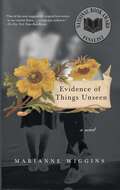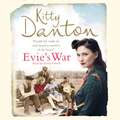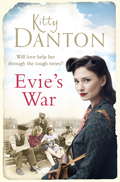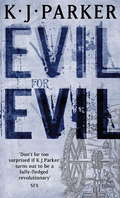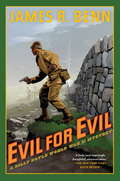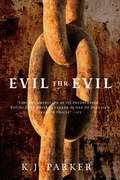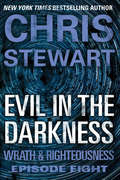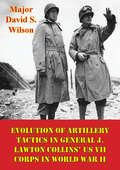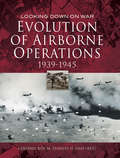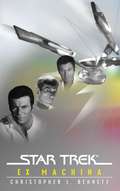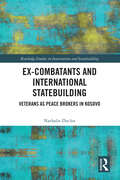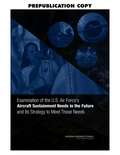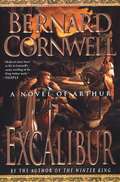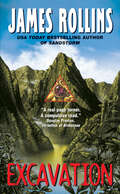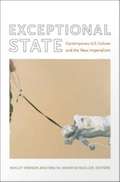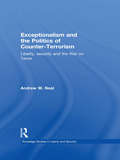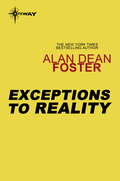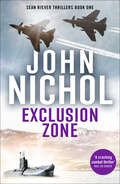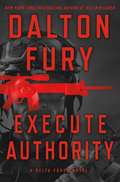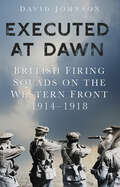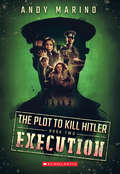- Table View
- List View
Everything is Illuminated
by Jonathan Safran FoerJonathan Safran Foer, a character bearing the same name as the author, is looking for the woman he believes saved his grandfather Safran from the Nazis.
Evidence Not Seen: A Woman's Miraculous Faith in a Japanese Prison Camp During WWII
by Darlene Deibler RoseThis is the story of the author's life as a young missionary to New Guinea, and her subsequent capture and imprisonment in a Japanese prison camp.
Evidence of Things Unseen: A Novel
by Marianne WigginsThis poetic novel, by the acclaimed author of John Dollar, describes America at the brink of the Atomic Age. In the years between the two world wars, the future held more promise than peril, but there was evidence of things unseen that would transfigure our unquestioned trust in a safe future.Fos has returned to Tennessee from the trenches of France. Intrigued with electricity, bioluminescence, and especially x-rays, he believes in science and the future of technology. On a trip to the Outer Banks to study the Perseid meteor shower, he falls in love with Opal, whose father is a glassblower who can spin color out of light.Fos brings his new wife back to Knoxville where he runs a photography studio with his former Army buddy Flash. A witty rogue and a staunch disbeliever in Prohibition, Flash brings tragedy to the couple when his appetite for pleasure runs up against both the law and the Ku Klux Klan. Fos and Opal are forced to move to Opal's mother's farm on the Clinch River, and soon they have a son, Lightfoot. But when the New Deal claims their farm for the TVA, Fos seeks work at the Oak Ridge Laboratory -- Site X in the government's race to build the bomb.And it is there, when Opal falls ill with radiation poisoning, that Fos's great faith in science deserts him. Their lives have traveled with touching inevitability from their innocence and fascination with "things that glow" to the new world of manmade suns.Hypnotic and powerful, Evidence of Things Unseen constructs a heartbreaking arc through twentieth-century American life and belief.
Evie's War: A charming and captivating wartime saga (Evie's Dartmoor Chronicles)
by Kitty DantonAfter discovering that her fiancé, Timmy, has been less than faithful, Evie is faced with a dilemma of the heart - she must try to mend their relationship or otherwise cut all ties and move on. Moving on from a first love is never easy though and it's further complicated by the fact that Timmy's mother is the headmistress at Evie's school and can't hear a bad word said against him.Luckily, Evie has two sisters and a close circle of friends to help her through the tough times and as the war brings British RAF officers and American GIs to the once quiet and calm village - as well as evacuees, Land Girls and wounded servicemen - life is going to be anything but dull.(p) 2016 Soundings
Evie's War: The gripping wartime saga you need to read this summer (Evie's Dartmoor Chronicles)
by Kitty DantonThe first in a new series of wartime sagas for fans of Maureen Lee, Katie Flynn and Dilly Court After finding out that her fiancé, Timmy, has been less than faithful, Evie is faced with a dilemma of the heart - she must try to mend their relationship or cut all ties and move on. But moving on from a first love is never easy and it's complicated by the fact that Timmy's mother is the headmistress at the school where Evie teaches and she won't hear a bad word said against him. Luckily, Evie has two sisters and a close circle of friends to help her through the tough times and as the war brings British RAF officers and American GIs to the once quiet and calm village - as well as evacuees, Land Girls and wounded servicemen - it seems that life is going to be anything but dull.Fans of Ellie Dean's Cliffehaven series will enjoy Evie's Dartmoor Chronicles series: 1. Evie's War2. Evie's Allies3. Evie's VictoryWhat readers are saying about Evie's War:'Evie is just the type of woman any one would love as a friend' Amazon Vine reviewer'I cannot wait for book two in the saga: Evie's Allies. A compelling read. I really enjoyed it.' Amazon reviewer'This novel both charms and surprises the readers' Amazon reviewer
Evil For Evil: The Engineer Trilogy: Book Two (Engineer Trilogy #2)
by K. J. Parker'This is grown-up fantasy blessed with humour, intelligence and... panache. A bravura display of intricate storytelling and artfully-doled-out revelations.' - SFX'A richly textured and emotionally complex fantasy...Highly recommended.' - Library Journal (Starred Review)The engineer Ziani Vaatzes designed and built a war. Thousands died as a consequence of his elaborate plan.The civil servant Manuo Psellus took the decision that started the war. The very foundations of his world are now threatened.The ruler Duke Valens brought the war on himself. Now he must decide whether to sacrifice his country to save his people.They embarked on the war for their own reasons, but as it takes on a life of its own they find they've become components in their own machine. And the machine, it seems, has one purpose: to render evil for evil.The follow-up to Devices and Desires continues to push the boundaries of fantasy fiction in a fast-moving mix of politics, action and intelligent world-building.Books by K.J. Parker:Fencer TrilogyThe Colours in the SteelThe Belly of the BowThe Proof HouseScavenger TrilogyShadowPatternMemoryEngineer TrilogyDevices and DesiresEvil for EvilThe EscapementSaloninusBlue and GoldThe Devil You KnowTwo of SwordsThe Two of Swords: Part 1The Two of Swords: Part 2The Two of Swords: Part 3NovelsThe CompanyThe Folding KnifeThe HammerSharpsSavagesSixteen Ways to Defend a Walled CityMy Beautiful Life
Evil for Evil (Billy Boyle World War II Mystery #4)
by James R. BennBenn continues to create fascinating behind-the-scenes mysteries from little-known facets of World War II history. . . . A fast-paced mix of action, adventure, and crime solving. --"Booklist. "
Evil for Evil (Engineer #2)
by K. J. ParkerCivitas Vadanis is in trouble. The Mezentines have declared war; and the Mezentines are very focused on their goals when it comes to killing. Duke Valens, of Civitas Vadanis, has a dilemma. He knows that his city cannot withstand the invading army; yet its walls are his only defence against the Mezentines. Perhaps the only way to save his people is to flee, but that will not be easy either. Ziani Vaatzes, an engineer exiled by the Mezentines for his abominable creations, has already proven that he can defend a city. But Ziani Vaatzes has his own concerns, and the fate of Civitas Vadanis may not be one of them.
Evil in the Darkness: Episode Eight
by Chris Stewart"It really grips you....I lost a lot of sleep reading it." -Tim LaHaye, co-author of the LEFT BEHIND series ONE MAN STANDS ALONE... "The battle was in motion. The same battle from long ago. The battle for the souls of men, for the soul of their country, for their own family. Eons of waiting and preparing. And now the final days were here." In the wake of a debilitating EMP attack on America, the rule of law has vanished. Amidst the chaos, the forces of Darkness use all means necessary to consolidate power into a new, illegal government formed without oversight or consent. As this clandestine group of powerful men prepares to introduce their handpicked leader to the world they learn of a major problem: The former Secretary of Defense, thought to be dead, may have somehow survived the attack. As next in the line of succession for the presidency, his presence would threaten the group's entire plan. With time running out before the public reveal of the chosen president, and the SecDef's life in grave danger, an all-or-nothing plan is hatched to infiltrate the illegal government and expose them to the world. Against the backdrop of torn-from-the-headlines Middle Eastern drama, the Wrath & Righteousness series is a fast-paced thriller that explores man's role in the eternal battle between good and evil. Chris Stewart, a world-record-setting Air Force pilot (fastest nonstop flight around the world), is the New York Times bestselling author of several books, including The Miracle of Freedom. Wrath & Righteousness is a ten episode e-book series by New York Times bestselling author Chris Stewart. Each episode is approximately 50,000-60,000 words (roughly two-thirds the length of a normal full-length novel). This series was adapted from the previously published The Great and Terrible series that was released from 2003-2008.
Evolution Of Artillery Tactics In General J. Lawton Collins’ US VII Corps In World War II
by Major David S. WilsonThis thesis examines the evolution of artillery tactics in World War II using General J. Lawton Collins' U.S. VII Corps as a case study. This study first reviews artillery doctrine and tactics during World War I and during the 1920s and 1930s, in which time future leaders like General Collins were military students.In 1943, General Collins commanded an infantry division on Guadalcanal where he was one of the first American generals to implement the Army's new doctrine of fire direction centers (FDCs) and massed fires using time on targets (TOTs). Collins then was selected to command the U.S. VII Corps for the invasion of Normandy and the subsequent breakout during OPERATION COBRA. From Normandy to the end of the war, Collins continued to hone his use of artillery based on his experience during the eleven-month campaign in Northwest Europe, contributing to his reputation as the best corps commander in World War II.This study looks at Army doctrine in 1944 to judge Collins' artillery tactics and concludes that he used established doctrine and that his tactics are the foundation for today's artillery tactics.
Evolution of Airborne Operations, 1939–1945 (Looking Down on War)
by Colonel Roy M. Stanley IIThe development of air transport in the early 20th Century led military strategists to examine the concept of inserting light infantry at key points behind enemy lines by air landing and air drop.The Germans were first off-the-mark with assaults in Norway and at Eben Emael in 1940. Crete saw a larger scale attack but while ultimately victorious the cost of men and equipment involved deterred any further Axis operation.The Allies on the other hand developed the concept dramatically with the large scale operation HUSKY in Sicily. While only partially successful there was massive loss of life and aircraft airborne operations were a key, if relatively minor, element of Op OVERLORD The D-Day Invasion.The most famous airborne operation was the large scale but ill-fated MARKET GARDEN. Almost successful the Arnhem battle goes down as a heroic defeat. The culmination of WWII airborne operations was the multi-division Rhine Crossing VARSITY.Expert author and collector Roy Stanley traces the history of airborne landings in words and pictures.
Evolution of the Cyber Domain: The Implications for National and Global Security
by The International Institute for Strategic StudiesCyber security has become a focal point for conflicting domestic and international interests, and increasingly for the projection of state power. The military utility of the cyber domain is linked to the economic and social potential of information and communications technologies (ICTs), while technologies with military and national-security applications have become essential to the conduct of modern life.In light of this, Evolution of the Cyber Domain provides a holistic review of the strategic, operational and technical issues at the centre of the international cyber-security debate. The Dossier charts and contextualises the key developments and trends that have shaped the cyber domain since the 1950s. As well as tracking the events and decisions underlying the military potential of ICTs, it examines the issues and policies that affect global governance of the internet.The Dossier analyses:• The geopolitics of international cyber security and technological development.• The challenges of creating methods for managing conflict within the cyber domain based on international law.• The tension between issues of privacy, freedom of information and national security.• Intelligence as a state practice in peace and war.• The development and use of cyber military capabilities.The Dossier is an important point of reference for further research and analysis on complex cyber-security issues, and it provides a series of insights into national positions, as well as regional and global agreements and policies. Evolution of the Cyber Domain is a useful resource for readers who seek a comprehensive picture of cyber affairs, and who wish to understand the social, economic and politico-military challenges that have guided the development and use of ICTs in the past six decades. By summarising the ways in which governments are addressing these challenges at the strategic level, it helps prepare decision-makers and researchers involved in the formulation of cyber-security policy, strategy and analysis. The Dossier also contains a glossary of the key terms and concepts in the cyber-security dialogue.
Ex Machina (Star Trek)
by Christopher L. BennettIn the aftermath of the astonishing events of Star Trek®: The Motion Picture, the captain and officers of the U.S.S. Enterprise remain haunted by their encounter with the vast artificial intelligence of V'Ger...and by the sacrifice and ascension of their friend and shipmate, Willard DeckerAs James T. Kirk, Spock, and Leonard McCoy attempt to cope with the personal fallout of that ordeal, a chapter from their mutual past is reopened, raising troubling new questions about the relationship among God, Man, and AI. On the recently settled world of Daran IV, the former refugees of the Fabrini worldship Yonada are being divided by conflicting ideologies, as those clinging to their theocratic past vie with visionaries of a future governed by reason alone. Now, echoes of the V'Ger encounter reverberate among the Enterprise officers who years ago overthrew the Oracle, the machine-god that controlled Yonada. Confronting the consequences of those actions, Kirk, Spock, and McCoy also face choices that will decide the fate of a civilization, and which may change them forever.
Ex-Combatants and International Statebuilding: Veterans as Peace Brokers in Kosovo (Routledge Studies in Intervention and Statebuilding)
by Nathalie DuclosThis book examines the international efforts to regulate violence in Kosovo since 1999 through the United Nations Mission in Kosovo (UNMIK) and covers 15 years of international presence.The book analyses the process of implementing international policies from a sociological perspective, and looks at the adaptations and arrangements of public policies achieved through the transactions of international actors with local actors, who are at the heart of policy implementation. In particular, it analyses the disarmament, demobilisation, and reintegration of combatants (DDR) programme and shows the extent to which it was co-produced with Kosovo Liberation Army (KLA) leaders co-opted by international administrators. These analyses take the opposite view to the work that considers ex-combatants as spoilers. In Kosovo, the combatant leaders acted as peace brokers, facilitating demobilisation and exercising disciplinary control over rank-and-file combatants. Their position as brokers helped them to take control of the new state being built under international administration. This book shows the importance of the relationship between ex-combatants and the state and illustrates the multiplicity of their possible trajectories, including political ones. To elucidate the dynamics of co-production in shaping DDR policies and hybridising international policies as well as in state formation, the book relies on around a hundred interviews with ex-combatants of the KLA and with international personnel, as well as on the archives of international organisations and observations in the field.This book will be of much interest to students of international statebuilding, peace and conflict studies, Balkan politics and international relations.
Examination of the U.S. Air Force's Aircraft Sustainment Needs in the Future and Its Strategy to Meet Those Needs
by Air Force Studies BoardThe ability of the United States Air Force (USAF) to keep its aircraft operating at an acceptable operational tempo, in wartime and in peacetime, has been important to the Air Force since its inception. This is a much larger issue for the Air Force today, having effectively been at war for 20 years, with its aircraft becoming increasingly more expensive to operate and maintain and with military budgets certain to further decrease. The enormously complex Air Force weapon system sustainment enterprise is currently constrained on many sides by laws, policies, regulations and procedures, relationships, and organizational issues emanating from Congress, the Department of Defense (DoD), and the Air Force itself. Against the back-drop of these stark realities, the Air Force requested the National Research Council (NRC) of the National Academies, under the auspices of the Air Force Studies Board to conduct and in-depth assessment of current and future Air Force weapon system sustainment initiatives and recommended future courses of action for consideration by the Air Force. Examination of the U. S. Air Force's Aircraft Sustainment Needs in the Future and Its Strategy to Meet Those Needs addresses the following topics: Assess current sustainment investments, infrastructure, and processes for adequacy in sustaining aging legacy systems and their support equipment. Determine if any modifications in policy are required and, if so, identify them and make recommendations for changes in Air Force regulations, policies, and strategies to accomplish the sustainment goals of the Air Force. Determine if any modifications in technology efforts are required and, if so, identify them and make recommendations regarding the technology efforts that should be pursued because they could make positive impacts on the sustainment of the current and future systems and equipment of the Air Force. Determine if the Air Logistics Centers have the necessary resources (funding, manpower, skill sets, and technologies) and are equipped and organized to sustain legacy systems and equipment and the Air Force of tomorrow. Identify and make recommendations regarding incorporating sustainability into future aircraft designs.
Excalibur: A Novel of Arthur (The Warlord Chronicles, No. #3)
by Bernard Cornwell[Back of Book] In The Winter King and Enemy of God Bernard Cornwell demonstrated his astonishing ability to make the oft-told legend of King Arthur fresh and new for our time. Now, in this riveting final volume of The Warlord Chronicles, Cornwell tells the unforgettable tale of Arthur's final struggles against the Saxons and his last attempts to triumph over a ruined marriage and ravaged dreams. This is the tale not only of a broken love remade, but also of forces both earthly and unearthly that threaten everything Arthur stands for. Peopled by princesses and bards, by warriors and magicians, Excalibur is a story of love, war, loyalty, and betrayal-the work of a magnificent storyteller at the height of his powers.
Excavation: A Novel
by James Rollins“A real page-turner….Rollins keeps the story in overdrive, with plenty of twists and turns before the final shocker.”—Douglas Preston, co-author of The Monster of Florence A classic adventure from James Rollins, the author of The Doomsday Key, The Last Oracle, The Judas Strain, Black Order, and other pulse-pounding, New York Times bestselling thrillers, Excavation carries readers deep into the jungles of South America, and into the terrifying heart of dark mysteries that should never be unearthed.
Exceptional State: Contemporary U.S. Culture and the New Imperialism
by Ashley Dawson Malini Johar SchuellerExceptional State analyzes the nexus of culture and contemporary manifestations of U. S. imperialism. The contributors, established and emerging cultural studies scholars, define culture broadly to include a range of media, literature, and political discourse. They do not posit September 11, 2001 as the beginning of U. S. belligerence and authoritarianism at home and abroad, but they do provide context for understanding U. S. responses to and uses of that event. Taken together, the essays stress both the continuities and discontinuities embodied in a present-day U. S. imperialism constituted through expressions of millennialism, exceptionalism, technological might, and visions of world dominance. The contributors address a range of topics, paying particular attention to the dynamics of gender and race. Their essays include a surprising reading of the ostensibly liberal movies Wag the Dog and Three Kings, an exploration of the rhetoric surrounding the plan to remake the military into a high-tech force less dependent on human bodies, a look at the significance of the popular Left Behind series of novels, and an interpretation of the Abu Ghraib prison photos. They scrutinize the national narrative created to justify the U. S. invasions of Afghanistan and Iraq, the ways that women in those countries have responded to the invasions, the contradictions underlying calls for U. S. humanitarian interventions, and the role of Africa in the U. S. imperial imagination. The volume concludes on a hopeful note, with a look at an emerging anti-imperialist public sphere. Contributors. Omar Dahbour, Ashley Dawson, Cynthia Enloe, Melani McAlister, Christian Parenti, Donald E. Pease, John Carlos Rowe, Malini Johar Schueller, Harilaos Stecopoulos
Exceptionalism and the Politics of Counter-Terrorism: Liberty, Security and the War on Terror (Routledge Studies in Liberty and Security)
by Andrew W. NealThis book is an analysis and critique of the concepts of ‘exception’ and ‘exceptionalism’ in the context of the politics of liberty and security in the so-called ‘War on Terror’. Since the destruction of the World Trade Centre on September 11th 2001, a notable transformation has occurred in political discourse and practice. Politicians and commentators have frequently made the argument that the rules of the game have changed, that this is a new kind of war, and that exceptional times require exceptional measures. Under this discourse of exceptionalism, an array of measures have been put into practice, such as detention without trial, ‘extraordinary rendition’, derogations from human rights law, sanction or connivance in torture, the curtailment of civil liberties, and aggressive war against international law. Situating exceptionalism within the post-9/11 controversy about the relationship between liberty and security, this book argues that the problem of exceptionalism emerges from the limits and paradoxes of liberal democracy itself. It is a commentary and critique of both contemporary practices of exceptionalism and the critical debate that has formed in response. Through a detailed assessment of the key theoretical contributions to the debate, this book develops exceptionalism as a critical tool. It also engages with the problem of exceptionalism as a discursive claim, as a strategy, as a concept, as a theoretical problem and as a practice. This is the first book to capture the importance of the exceptionalism debate in a single volume, and will be of much interest to students of critical security studies, political philosophy, IR theory and sociology.
Exceptions to Reality
by Alan Dean FosterAs is evident from his many thrilling novels, Alan Dean Foster is a master at creating other worlds in an array of genres. Now he turns his imagination to the short story in these spectacular tales of outer space, cyberspace, ancient gods, modern demons and mortal horror, including:The Panhandler - A predatory lawyer encounters a fabled boyhood hero and falls victim to the less innocent intrigues of eternal youth.Growth - Not even his minidrag Pip can save Flinx from the overly intimate advances of an intruder who goes entirely too far.Basted - A lowly, hen-pecked Egyptian discovers that the Pharaoh's tomb holds exactly what he needs for a whole new life.The Killing of Bad Bull - A man with a knack for getting gambling's one-armed bandits to give it up finds himself at the top - of several hit lists.At Sea - A poor Scandinavian captain forced into running drugs is shown a way out of his desperate straits with the help of five beautiful blondes who are simply out-of-this-world.
Exclusion Zone (The Sean Riever Thrillers)
by John NicholTwo Royal Air Force pilots must defend the Falklands from more attacks in this action-packed thriller by the bestselling author of Point of Impact. The Falklands, 1999—a vital strategic stronghold and oil-rich gem in the South Atlantic. For RAF pilot Sean Riever, it is a place of ghosts. For Jane Clark, his co-pilot, a place of tough decisions. An air of menace hangs over the desolate, battle-scarred landscape; present dangers and past mysteries lurk in the shadows on the skyline. Then a Royal Navy nuclear submarine disappears, and Argentine jet fighters penetrate the Exclusion Zone. As Sean and his companions stave off wave after wave of enemy attacks, their defense becomes an epic battle for survival—in which victory can only be achieved at a terrible price . . . A pulse-pounding, high-octane action thriller, Exclusion Zone is a tour de force, perfect for fans of Frederick Forsyth, Mark Greaney, and Kyle Mills.Praise for Exclusion Zone &“Fresh and compelling . . . As good as anything written by Jeffrey Archer or Dick Francis.&” —Daily Mail&“A cracking combat thriller with a delicate love story.&” —Mail on Sunday
Execute Authority: A Delta Force Novel
by Dalton FuryThe explosive conclusion to the New York Times bestselling series.In Dalton Fury's Execute Authority, Kolt “Racer” Raynor and his Delta Force squadron are in Greece, providing VIP security for the newly elected—and deeply controversial—American president on his desperate mission to hold the NATO alliance together.Then, the unimaginable happens. Just as the president is arriving, an assassin’s bullet takes the life of the Greek prime minister. The president is safe, but Raynor recognizes the killer—Rasim Miric—by his grisly signature: a bullet through his target’s left eye.The hunt for the assassin ends when Miric, to all appearances, blows himself up in an explosion that levels an apartment block, but Raynor refuses to accept that the sniper is really dead. Miric’s grudge is with America, and one American in particular—the Delta Force operator who cost him an eye, Kolt Raynor. Raynor believes that Miric’s killing spree is only just beginning, and his suspicions are proved true when Miric is photographed crossing the border into the United States.Forbidden by law from operating on American soil, Raynor will have to bend the rules until they break, risking everything in order to run the assassin down before he can strike again.But what Raynor doesn’t realize is that Rasim Miric is also hunting him.
Executed at Dawn: British Firing Squads on the Western Front 1914-1918
by David JohnsonMuch has been written about the 302 British and Commonwealth soldiers who were executed for military offences during the First World War, but there is usually only a passing reference to those who took part – the members of the firing squad, the officer in charge, the medical officer and the padre. What are their stories? Through extensive research, David Johnson explores the controversial story of the men forced to shoot their fellow Tommies, examining how they were selected; how they were treated before, during, and after the executions; and why there were so many procedural variations in the way that the executions were conducted.
Execution (The Plot to Kill Hitler #2)
by Andy MarinoBased on the real-life scheme to take down one of history's greatest monsters, this heart-pounding trilogy puts two courageous kids at the center of the plot to kill Adolf Hitler.Summer 1944.Max, Gerta, and their parents have abandoned their home and relocated to a safehouse in a different Berlin neighborhood. The Hoffmanns share the tight quarters with the daughter of a captured Becker Circle conspirator -- Kat Vogel, who is Gerta's age. Though they have strict orders to stay inside unless absolutely necessary, the three kids sneak out regularly, all while concocting a plan to keep the spirit of their resistance alive. They're going to burn down the headquarters of the Hitler Youth.Meanwhile, Claus Von Stauffenberg, a member of Operation Valkyrie's inner circle, vows to carry out the assassination of Adolf Hitler himself. And he will do it soon. Time is running out.The plots are carried out -- and a small, split-second decision changes the trajectory of history forever.
Execution for Duty: The Life, Trial & Murder of a U-boat Captain
by Peter C. HansenA true story of betrayal and murder withing the German navy and Nazi military court is revealed in this WWII biography of a U boat Captain. In 1937, Oskar Heinz Kusch joined the German Navy. By the time he finished naval college, the Second World War had begun. Kusch volunteered to serve on U boats and, with his distinguished record, he soon gained his own command in the 2nd U boat Flotilla. Before his second operational voyage as Captain of U 154, three new junior officers joined the submarine. Confirmed Nazi patriots who constantly praised their heroes of the Reich, they were not popular aboard—especially with Kusch, who was ideologically opposed to the Nazi regime despite his military service. During that voyage, the three hatched a plan to dishonor their Captain and accuse him of treason. The trial was corrupt and rigged. No latitude was given from higher authorities and no account of his distinguished career was taken into consideration. To the amazement of the court, orders were given that Kusch was to be shot.

